2
Board and Standing Committees: Activities and Membership
The Space Studies Board (SSB) of the National Academies of Sciences, Engineering, and Medicine1 and its standing committees provide strategic direction for and oversee activities of its ad hoc study committees (see Chapter 3), interact with sponsors, and serve as a communications conduit between the government and the scientific community. They do not provide formal advice and recommendations and, therefore, are not subject to the Federal Advisory Committee Act, Section 15.
During 2016, the SSB had five standing committees representing various disciplines: the Committee on Astrobiology and Planetary Science (CAPS), the Committee on Astronomy and Astrophysics (CAA; jointly with the Board on Physics and Astronomy, BPA), the Committee on Earth Science and Applications from Space (CESAS), the Committee on Solar and Space Physics (CSSP), and the Committee on Biological and Physical Sciences in Space (CBPSS; jointly with the Aeronautics and Space Engineering Board, ASEB).
SPACE STUDIES BOARD
HIGHLIGHTS OF SPACE STUDIES BOARD ACTIVITIES
The SSB held its spring meeting in Washington, D.C., on April 26-28, 2016. The first day was a joint meeting of the SSB and the ASEB. The boards held discussions with General Charlie Bolden (NASA Administrator), Ralph Roe (NASA Chief Engineer), Jim Adams (NASA Deputy Chief Technologist), and Gale Allen (NASA Deputy Chief Scientist). They then had a discussion with Senator Gary Peters (D-MI) and received an update from staffers from Capitol Hill (Tom Hammand and Pam Whitney, House Science Committee, and Nick Cummings, Senate Commerce, Science and Transportation Committee) and from White House staff (Paul Shawcross and Grace Hu, Office of Management and Budget, and Meredith Drosback and Ben Roberts, Office of Science and Technology Policy [OSTP]). In the afternoon, the boards received updates on NASA Space Technology Mission Directorate programs (James Reuter) and NASA Human Exploration and Operations Mission Directorate programs (William Gerstenmaier). The end of the first day was devoted to a session on “The Future of Low Earth Orbit—Moving Toward a Commercial Market,” which included an update on CBPSS (Betsy Cantwell, co-chair); NASA’s vision for low Earth orbit (LEO) (Sam Scimemi, NASA); and a panel and boards discussion that included Carissa Christensen (Tauri Group), John Elbon (Boeing), Mike Gold (Chair, Commercial Space Transportation Advisory
___________________
1 Effective July 1, 2015, the institution is called the National Academies of Sciences, Engineering, and Medicine. References in this report to the National Research Council are used in an historical context identifying programs prior to July 1.
Committee), Ben Roberts (OSTP), Greg Johnson (CASIS, the Center for the Advancement of Science in Space), and George Nield (Federal Aviation Administration).
The second and third days were focused on SSB activities and included updates from the SSB/BPA standing committee chairs, including Todd Hoeksema (CSSP), Joyce Penner (CESAS), Phil Christensen (CAPS), and Steve Ritz and Marcia Rieke (CAA). The Board then held a discussion with John Grunsfeld (Associate Administrator, NASA Science Mission Directorate [SMD]) and the SMD division directors or their representatives, including Mike Freilich (Earth Science), Peg Luce (Heliophysics), David Schurr (Planetary Science), and Paul Hertz (Astrophysics). A focus session on the status of selected decadal priority missions included status updates on Mars 2020 (Ken Williford, Jet Propulsion Laboratory [JPL]); the James Webb Space Telescope (JWST) (Eric Smith, NASA Headquarters); Wide Field Infrared Survey Telescope (WFIRST) (Neil Gehrels, NASA Goddard Space Flight Center); Europa Mission (Louise Prockter, Johns Hopkins University Applied Physics Laboratory, and Barry Goldstein, JPL); and Solar Probe Plus (John Lee, NASA Headquarters). The afternoon was devoted to international issues and included an update on the European Space Sciences Committee (ESSC) by Athena Coustenis (ESSC Chair) and on the Committee on Space Research (COSPAR) by David Smith (SSB staff). The final day included updates and key issues at the National Oceanic and Atmospheric Administration (NOAA) and the National Science Foundation’s (NSF’s) Directorate for Geosciences from Steve Volz (NOAA) and Paul Shepson (NSF Geoscience). Staff then reported on several new and ongoing studies.
The SSB did not met during the third quarter, but the SSB Executive Committee (XCOM) met in Woods Hole, Massachusetts, on August 11-12, 2016. The XCOM had discussions regarding the most pressing issues facing different groups in the space community, including standing committee chairs (CAA, CAPS, CESAS, CSSP, and CBPSS); the NASA Advisory Council (NAC) (Bradley Peterson, NAC Science Committee Chair); NASA SMD (Geoff Yoder, Acting Associate Administrator, NASA SMD); congressional views (Pam Whitney, House Science Committee); and the White House (Tammy Dickinson, OSTP). They also discussed some future activities and potential challenges, including planetary protection, strategic issues in space for the new administration, the journey to Mars and the implications for science, and open code and NASA science. The XCOM also received a briefing on the new report New Worlds, New Horizons: A Midterm Assessment from the committee chair, Jackie Hewitt, and then had a discussion on planning for the next decadal survey, Astro2020. And finally, the XCOM had a planning discussion about a focus session on space weather that will be held at the November meeting.
The SSB held its fall meeting November 2-4 in Irvine, California. The morning session on the first day included reports from standing committee co-chairs Marcia Rieke and Steve Ritz (CAA), Phil Christensen (CAPS), Michael King (CESAS), Todd Hoeksema (CSSP), and Rob Ferl (CBPSS); and plans for the 2017 Space Science Week and the new discipline committees (more information below). The afternoon session included an update on the planning for COSPAR 2018 in Pasadena, California (Gregg Vane); an update on other COSPAR activities (David Smith, SSB staff); and an update from Athena Coustenis (ESSC Chair) on the ESSC’s activities. That was followed by a session with Thomas Zurbuchen (NASA Associate Administrator for SMD) on a status report from NASA SMD; and a session on “Current and Future Issues and Activities of the SSB,” including report briefings on Extending Science—NASA’s Space Science Mission Extensions and the Senior Review Process and New Worlds, New Horizons: A Midterm Assessment; and a discussion of a future potential study on an open code future for space science. Day 2 included a session on planning for the Joint SSB/ASEB symposium on civil space policy, which will take place May 2, 2017, during the joint SSB/ASEB spring meetings; a session on setting a research agenda for space weather; and an overview of the planning for the SSB workshop “Searching for Life Across Space and Time” (Jim Kasting, planning committee chair). That was followed by a talk from Joshua Brost (SpaceX) on SpaceX and plans for the Red Dragon missions to Mars and a session on the interconnectivity or interdependence of missions across the SMD disciplines with perspectives from astrobiology (Penny Boston, NASA’s Astrobiology Institute) and astronomy (Chryssa Kouveliotou, George Washington University). Day 2 ended with a science talk from Kevin Hand (JPL) on the science of ocean worlds.
SPACE STUDIES BOARD MEMBERSHIP
July 1, 2015–June 30, 2016
David N. Spergel, Princeton University (chair2)
Robert D. Braun, Georgia Institute of Technology (vice chair)
James Anderson, Harvard University
James Bagian, University of Michigan
Jeff M. Bingham, Consultant
Penelope J. Boston, New Mexico Institute of Mining and Technology
Mary Lynne Dittmar, Dittmar Associates
Joseph Fuller, Jr., Futron Corporation
Thomas R. Gavin, California Institute of Technology
Neil Gehrels, NASA Goddard Space Flight Center
Sarah Gibson, National Center for Atmospheric Research
Wesley T. Huntress, Carnegie Institution of Washington
Anthony C. Janetos, Boston University
Chryssa Kouveliotou, George Washington University
Saul Perlmutter, Lawrence Berkeley National Laboratory
Louise M. Prockter, Johns Hopkins University, Applied Physics Laboratory
Mark Thiemens, University of California, San Diego
Meenakshi Wadhwa, Arizona State University
Thomas H. Zurbuchen, University of Michigan
July 1, 2016–June 30, 2017
Fiona Harrison, California Institute of Technology (chair3)
Robert D. Braun, University of Colorado, Boulder (vice chair)
David N. Spergel, Princeton University and Center for Computational Astrophysics at the Simons Foundation (vice chair4)
James G. Anderson, Harvard University
Jeff M. Bingham, Consultant
Jay C. Buckey, Geisel School of Medicine at Dartmouth
Mary Lynne Dittmar, Dittmar Associates, Inc.
Joseph Fuller, Jr., Futron Corporation
Thomas R. Gavin, California Institute of Technology
Neil Gehrels,5 NASA Goddard Space Flight Center
Sarah Gibson, National Center for Atmospheric Research
Wesley T. Huntress, Jr., Carnegie Institution of Washington (retired)
Anthony C. Janetos, Boston University
Chryssa Kouveliotou, George Washington University
Dennis P. Lettenmaier, University of California, Los Angeles
Rosaly M.C. Lopes, Jet Propulsion Laboratory
David J. McComas, Princeton University
Larry Paxton, Johns Hopkins University, Applied Physics Laboratory
Saul Perlmutter, Lawrence Berkeley National Laboratory
Eliot Quataert, University of California, Berkeley
Barbara Sherwood Lollar, University of Toronto
Harlan E. Spence, University of New Hampshire
Mark Thiemens, University of California, San Diego
Meenakshi Wadhwa, Arizona State University
Ex Officio and Liaison Participants
Charles F. Kennel, University of California, San Diego (liaison; U.S. Representative to COSPAR)
Lester Lyles, The Lyles Group (ex-officio; chair, Aeronautics and Space Engineering Board)
Athena Coustenis, National Centre for Scientific Research of France (liaison; chair, European Space Science Committee)
___________________
2 Term as chair ended December 31, 2016.
3 Term began January 1, 2017.
4 Term as vice chair began January 1, 2017.
5 Deceased on February 6, 2017.
Membership of the SSB Executive Committee
July 1, 2015–June 30, 2016
David N. Spergel, Princeton University (chair)
Robert D. Braun, Georgia Institute of Technology (vice chair)
Mary Lynne Dittmar, Dittmar Associates
Neil Gehrels, NASA Goddard Space Flight Center
Wesley T. Huntress, Carnegie Institution of Washington
Anthony Janetos, Boston University
Chryssa Kouveliotou, George Washington University
Thomas H. Zurbuchen, University of Michigan
July 1, 2016–June 30, 2017
Fiona Harrison, California Institute of Technology (chair6)
Robert D. Braun, University of Colorado, Boulder (vice chair)
David N. Spergel, Princeton University and Center for Computational Astrophysics at the Simons Foundation (vice chair7)
Jeff M. Bingham, Consultant
Mary Lynne Dittmar, Dittmar Associates, Inc.
Sarah Gibson, National Center for Atmospheric Research
Anthony C. Janetos, Boston University
Chryssa Kouveliotou, George Washington University
Rosaly M.C. Lopes, Jet Propulsion Laboratory
Staff in 2016
Michael H. Moloney, Director for Space and Aeronautics
Arthur A. Charo, Senior Program Officer
Sandra J. Graham, Senior Program Officer
David H. Smith, Senior Program Officer
Dwayne A. Day,* Senior Program Officer, ASEB
David B. Lang,* Senior Program Officer, BPA
Abigail A. Sheffer, Program Officer
Katie Daud, Research Associate (through December)
Mia Brown, Research Associate (from December)
Marchel Holle, Research Associate (from October)
Charlie Harris, Research Associate (through August)
Andrea Rebholz,* Program Associate
Dionna Wise, Program Associate
Anesia Wilks, Senior Program Assistant
Carmela J. Chamberlain, Administrative Coordinator
Meg A. Knemeyer, Financial Officer
Su Liu, Senior Financial Assistant
Celeste A. Naylor, Information Management Associate
Tanja E. Pilzak, Manager, Program Operations
Christine Mirzayan Fellow
Nathan Boll, 2016 Christine Mirzayan Science and Technolgy Policy Graduate Fellow
___________________
* Staff from other boards who are shared with SSB.
6 Term began January 1, 2017.
7 Term as vice chair began January 1, 2017.
Space Policy Interns
Cherie Achilles, 2016 Lloyd V. Berkner Space Policy Intern
Sara Denbo, 2016 Lloyd V. Berkner Space Policy Intern
Caroline Juang, 2016 Lloyd V. Berkner Space Policy Intern
Sarah Peacock, 2016 Lloyd V. Berkner Space Policy Intern
U.S. NATIONAL COMMITTEE FOR COSPAR
Planning for COSPAR 2018 passed another milestone with the successful conclusion of the inspection tour of the Pasadena Convention Center, adjacent hotels, and other facilities by COSPAR’s leadership on January 25-26. Two months later, Gregg Vane, chair of the Pasadena 2018 Local Organizing Committee, and Thomas Prince and Rosaly Lopes, chair and vice chair, respectively, of the Pasadena 2018 Science Program Committee, gathered first-hand experience on the organizing of a major COSPAR event by participating at COSPAR headquarters in Paris, France, on March 22 in the final organizing meeting for 2016 Istanbul Scientific Assembly. The March 2016 Paris business meetings also featured the annual meetings of the COSPAR Scientific Advisory Committee (March 23) and Bureau (March 24) and the first organizing meeting (March 21) for the third of COSPAR’s new series of “off-year” topical symposia. The theme of the third symposium is “space research with new technology: from nano- to micro-satellites and beyond.” The third symposium is scheduled to be held on Jeju Island, South Korea, on September 18-22, 2017.
The 41st COSPAR Assembly was to have been in Istanbul on July 30-August 7, 2016, but it was cancelled for security concerns following an attempted coup in Turkey. The cancellation decision was made following consultations between COSPAR President Lennard Fisk and the executive director of the COSPAR Secretariat and was based on advice received from several members of the Bureau and Council as well as COSPAR officers and organizers of scientific events scheduled to be held at the Istanbul assembly.
COSPAR devoted much of the latter half of 2016 to efforts to recover and recoup the business, organizational, and planning activities that were scheduled to have been undertaken by the Council, Bureau, Scientific Commissions, and Panels during the cancelled Istanbul assembly. The first orders of business for the Council were the approval of COSPAR’s budget for 2017 and the selection of the site for the 2020 Scientific Assembly. The four teams contending for the 2020 assembly—representing Lausanne, Prague, Shanghai, and Sydney—put together video presentations extoling the virtues of their proposed locations. Council members reviewed these presentations and the report of a site-assessment group empaneled by COSPAR’s president and expressed their preferences via an electronic ballot. The result was that Sydney, Australia, will host COSPAR’s 2020 scientific assembly. Similarly, COSPAR’s Scientific Commissions and the Panels worked via email and other virtual modalities to outline the scientific sessions to be held at the 2018 assembly in Pasadena, California, on July 14-22, 2018.
The next round of COSPAR business meetings (including the first meeting of the Science Program Committee for the Pasadena Assembly) will take place at COSPAR headquarters in Paris on March 20-22, 2017.
U.S. Representative to COSPAR
Charles F. Kennel, Scripps Institute of Oceanography, University of California, San Diego
Staff
David H. Smith, Senior Program Officer, SSB (Executive Secretary of U.S. National Committee for COSPAR)
Carmela J. Chamberlain, Administrative Coordinator, SSB
STANDING COMMITTEES
Space Science Week (www.nationalacademies.org/spacescienceweek) was held March 29-31, 2016, in Washington, D.C. All five of the SSB’s active standing committees met in parallel (see descriptions of the individual standing committee meetings below). On the afternoon of March 29, the standing committees conducted a plenary session at which there was a presentation on the NASA SMD budget and its current program and priorities by John Grunsfeld, SMD Associate Administrator. The committees then held a focus session on International Programs
and Cooperation, which began with individual presentations from Fabio Favata, European Space Agency (ESA), Maurice Borgeaud, ESA, Chi Wang, Chinese Academy of Sciences, Masaki Fujimoto, Japan Aerospace Exploration Agency, and Pascal Ehrenfreund, German Aerospace Center (DLR). That was followed by a discussion panel where the international members were joined by John Grunsfeld, NASA, and moderator David Spergel, SSB Chair. The afternoon concluded with a briefing from Vicky Hamilton, Southwest Research Institute, and co-chair for the Committee on NASA Science Mission Extension, on the committee’s progress; a briefing by Tom Hammond, House Science, Space and Technology Committee; and a briefing from Angela Jackman from NASA’s Marshall Space Flight Center on the use of the Space Launch System for science.
On the evening of March 30, the Space Science Week public lecture was given by Alan Stern, Southwest Research Institute, principal investigator for New Horizons. A video replay of “Mission to Pluto: Exploring the Frontier of Our Solar System” is available at http://sites.nationalacademies.org/SSB/SSB_170496.
The standing committees supported by NASA SMD (CAA, CAPS, CESAS, and CSSP) were reconstituted as discipline committees on January 1, 2017. The new status will enable them to draft reports containing consensus conclusions and findings on the implementation of their respective decadal surveys.
COMMITTEE ON ASTROBIOLOGY AND PLANETARY SCIENCE
The Committee on Astrobiology and Planetary Science held its first meeting of 2016 in conjunction with the SSB’s annual Space Science Week, March 29-31, 2016. A new co-chair—Christopher House—and seven new members—Bethany Ehlmann, Kevin Hand, Sarah Horst, William McKinnon, David Stevenson, Sarah Stewart, and Elizabeth Turtle—made their debut. The committee heard briefings on the status of NASA’s Planetary Science Division, Mars Exploration Program, and Astrobiology Program by James Green, James Watzin, and Mary Voytek, respectively. Athena Coustenis (Paris Observatory) gave an update on ESA’s planetary science missions, and Gerda Hornek (DLR, retired) described the results of the AstRoMap astrobiology roadmap study. Presentations on the results from the New Horizon’s mission to Pluto and the Dawn mission to Ceres were given by Alan Stern (Southwest Research Institute) and Christopher Russell (University of California, Los Angeles). Caleb Scarf (Columbia University) described the results of a recent workshop to define a strategy for origins of life research, and Carolyn Porco (Space Science Institute) presented the case for future studies of Enceladus. In addition, the committee continued its close oversight of the planning for a Europa mission. The committee’s discussions also included the pros and cons for the inclusion of “ocean worlds” missions in the call for the fourth New Frontiers mission and reviewed the draft statement of task for the forthcoming midterm decadal review.
The annual fall meeting of CAPS took place at the National Academies’ Beckman Center in Irvine, California, on September 14-15. The committee heard briefings on the status of NASA’s Planetary Science Division and Mars Exploration Program (from Michael Meyer, NASA Headquarters), Astrobiology Program (Mary Voytek, NASA Headquarters), Sample Science Facilities (from Kevin McKeegan, University of California, Los Angeles), Mars Science Laboratory (Ashwin Vasavada, JPL), Europa Clipper mission (from Robert Pappalardo and Barry Goldstein, JPL), and Europa lander science definition team (Allison Murray, Desert Research Institute). In addition, Martin Rahm (Cornell University) discussed the chemistry of Titan, William McKinnon (Washington University) gave reports on several recent workshops concerning ocean worlds, and Linda Spilker (JPL) reviewed the scientific results from Cassini and previewed the spacecraft’s “Grand Finale.” Tim Lyons (University of California, Riverside) discussed his recent work on the rise of oxygen in Earth’s atmosphere during the mid-Proterozoic and Victoria Hamilton (Southwest Research Institute) presented the conclusions and recommendations in the SSB’s recent report on extended space-science missions.
During final months of 2016, efforts focused on the transition of CAPS from a standing committee to a discipline committee. As part of this transition, new appointments will be made during the first quarter of 2017 to replace members whose terms have finished or to replace members whose specific individual circumstances are incompatible with the stricter conflict-of-interest requirements associated with the committee’s enhanced status. It is anticipated that all the membership changes will be completed in time for the next meeting of CAPS, which will be held at the National Academy of Sciences Building in Washington, D.C., as part of Space Science Week on March 28-30, 2017.
A historical summary of a selection of SSB advisory reports on astrobiology and planetary protection is presented in Figure 2.1. A historical summary of a selection of SSB advisory reports on solar system exploration is presented in Figure 2.2.
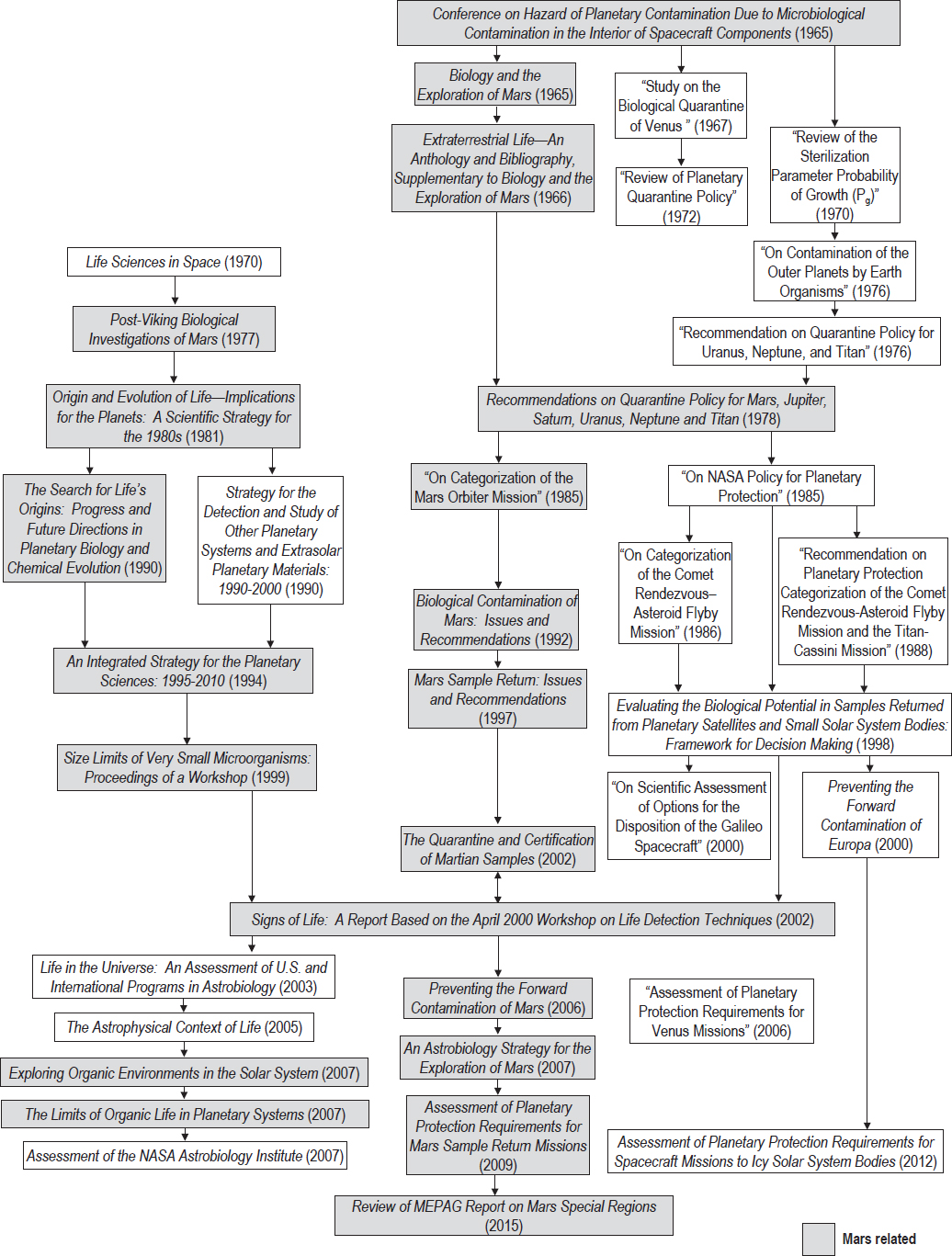
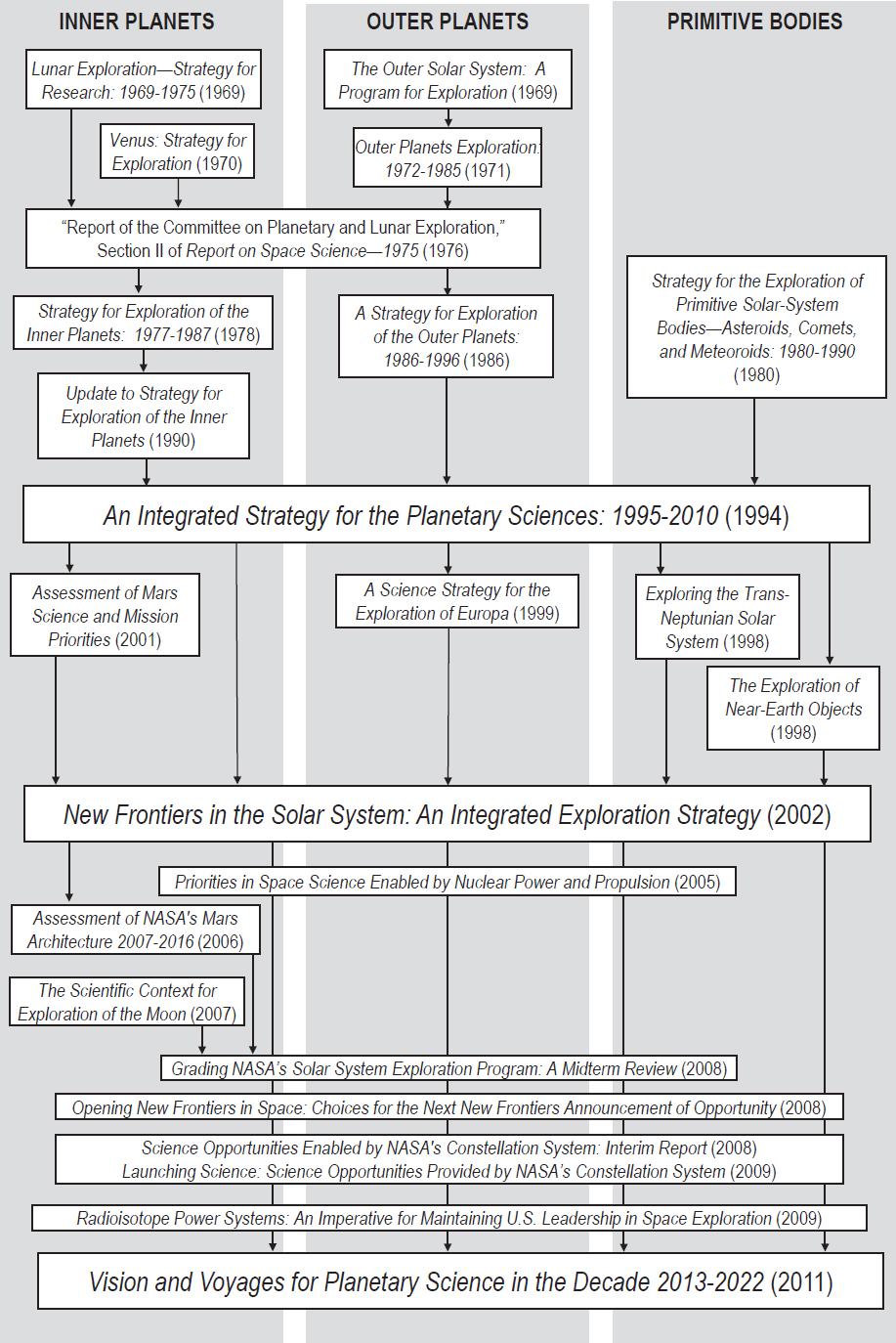
Membership
Philip R. Christensen,* Arizona State University (co-chair)
James G. Ferry,‡ Pennsylvania State University (co-chair)
Christopher H. House,† Pennsylvania State University (co-chair)
Sushil K. Atreya,* University of Michigan
Amy C. Barr,‡ Independent Consultant
Richard P. Binzel,* Massachusetts Institute of Technology
Ronald Breaker, Yale University
John Clarke, Boston University
Geoffrey Collins,* Wheaton College
Bethany L. Ehlmann,† California Institute of Technology
Pascale Ehrenfreund, German Aerospace Center
Kevin Hand,† Jet Propulsion Laboratory
Sarah M. Hörst,† Johns Hopkins University
James F. Kasting, Pennsylvania State University
Stephen Mackwell,* Lunar and Planetary Institute
William B. McKinnon,† Washington University
Norman R. Pace, University of Colorado, Boulder
Gary Ruvkun,* Massachusetts General Hospital
Mark P. Saunders, Independent Consultant
Norman H. Sleep,‡ Stanford University
David J. Stevenson,† California Institute of Technology
Sarah T. Stewart,† University of California, Davis
Cristina Takacs-Vesbach,‡ University of New Mexico
Elizabeth P. Turtle,† Johns Hopkins University, Applied Physics Laboratory
Roger V. Yelle,‡ University of Arizona
Staff
David H. Smith, Senior Program Officer, SSB
Mia Brown, Research Associate, SSB (from December)
Katie Daud, Research Associate, SSB (through December)
Andrea Rebholz,§ Program Coordinator, ASEB
COMMITTEE ON ASTRONOMY AND ASTROPHYSICS
The Committee on Astronomy and Astrophysics met in-person during Space Science Week on March 29-31, 2016. CAA met by itself on the morning of March 29, all day March 30, and the morning of March 31. The afternoon of March 29 was spent in plenary with all five standing committees. The CAA meeting featured presentations from Alan Dressler on the report The Space Science Decadal Surveys: Lessons Learned and Best Practices; Vicky Kalogera on the Laser Interferometer Gravitational-Wave Observatory and gravitational wave astrophysics; Paul Hertz on NASA Astrophysics Division activities; Angela Olinto on the Astronomy and Astrophysics Advisory Committee annual report; Jim Ulvestad on NSF Division of Astronomical Sciences activities; and Kathy Turner on Department of Energy (DOE) High Energy Physics activities. The meeting also featured much discussion of planning for the next decadal survey in astronomy and astrophysics. Prior to this meeting, CAA held a teleconference to conduct its annual balance and composition discussion and review the agenda for the upcoming meeting.
___________________
* Term ended January 31, 2017.
† Became a member March 2, 2016.
‡ Term ended January 31, 2016.
§ Staff from other Boards who are shared with the SSB.
CAA did not meet in person during the second or third quarters but continued to have active discussions about preparations for the next decadal survey. Both co-chairs, Steven Ritz and Marcia Rieke, represented the committee at the SSB meeting on April 26-27 in Washington D.C., and Marcia Rieke participated in the BPA meeting on May 3-4 in Washington, D.C., and represented the committee at the SSB XCOM meeting on August 11-12 in Woods Hole, Massachusetts.
CAA met in-person on October 31 to November 1, 2016, in Irvine, California. The meeting opened with discussions with Jim Ulvestad (NSF Astronomy), Paul Hertz (NASA Astrophysics), and Kathy Turner (DOE High Energy Physics) about their perspectives on and preparations for the next decadal survey in astronomy and astrophysics. The committee then held a focus session on planning for the next survey and discussed such subjects as the study’s scope, timing, the cost and technical evaluation process, and community outreach and input, among others. The meeting also featured talks by Jackie Hewitt, Massachusetts Institute of Technology, on the mid-decadal astronomy and astrophysics report (the authoring committee for which she chaired); Dave Silva, National Optical Astronomy Observatory, on the state of the ground-based optical and infrared system; Fabio Favata, ESA, on developments with ESA’s Athena and L3 (eLISA) missions; Eric Smith, NASA, on JWST’s progress; and Neil Gehrels and Kevin Grady, NASA, on progress on WFIRST. The meeting closed with committee discussions about the next meeting during Space Science Week 2017.
A historical summary of a selection of SSB advisory reports on astronomy and astrophysics is presented in Figure 2.3.
Membership
Marcia J. Rieke, University of Arizona (co-chair)
Steven M. Ritz,* University of California, Santa Cruz (co-chair)
Jeremiah K. Darling,† University of Colorado, Boulder
Megan Donahue, Michigan State University
Thomas Greene,† NASA Ames Research Center
Lee W. Hartmann,* University of Michigan
Vassiliki Kalogera,* Northwestern University
Bruce Macintosh, Stanford University
Christopher F. McKee, University of California, Berkeley
Rene A. Ong,† University of California, Los Angeles
Mark M. Phillips,* Carnegie Institution for Science
James M. Stone,† Princeton University
Alexey Vikhlinin,† Harvard-Smithsonian Center for Astrophysics
Eric M. Wilcots, University of Wisconsin, Madison
A. Thomas Young, Lockheed Martin Corporation (retired)
Staff
David B. Lang, Senior Program Officer, BPA
Mia Brown, Research Associate, SSB (from December)
Katie Daud, Research Associate, SSB (through December)
Dionna Wise, Program Coordinator, SSB
___________________
* Became a member September 18, 2016.
† Term ended December 31, 2016.
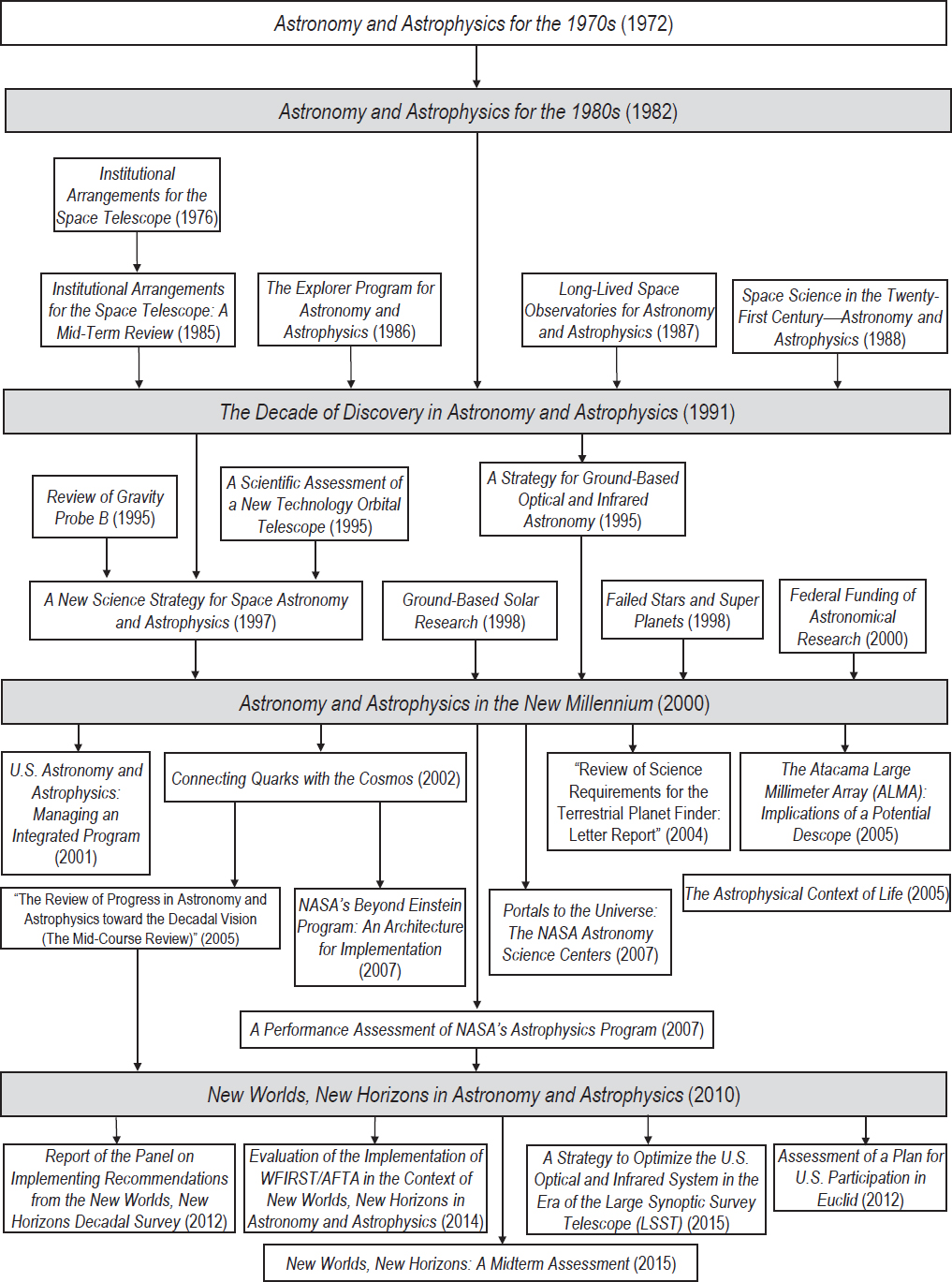
COMMITTEE ON BIOLOGICAL AND PHYSICAL SCIENCES IN SPACE
The Committee on Biological and Physical Sciences in Space held its first 2016 meeting on March 29-31 in Washington, D.C., as part of Space Science Week. The primary focus of the meeting was a 1-day symposium titled “Research in Commercial LEO,” which had been planned and coordinated by the committee with the input of CASIS and NASA following the committee’s October 2015 meeting. The symposium was organized to explore the landscape in which commercial support for research in LEO is evolving by bringing together participants from the potential commercial provider and customer communities for research services in LEO, along with key players in the development of a commercial ecosystem. The event included presentations, moderated panel sessions, and roundtable discussion among the committee, speakers, and key NASA and CASIS participants. The providers panel featured industry representatives such as Bigelow Aerospace, Sierra Nevada, Orbital ATK, and Nano-Racks. The afternoon panel featured a diverse range of customer perspectives from Eli Lilly, Merck, ACME Advanced Materials, Inc., LaunchPad Medical, and Purdue University. The meeting participants also heard about NASA planning for commercial LEO from Sam Scimemi, NASA Headquarters; LEO Ecosystems from Cynthia Bouthot and Michael Roberts of CASIS; and economic considerations for LEO research platform markets from Ioana Cozmuta, NASA Ames Research Center. During the meeting, the committee also received a status update from Marshall Porterfield, NASA, on the life and physical sciences program and discussed the upcoming midterm review of the decadal survey.
CBPSS did not meet in person during the second quarter, but was in discussions with NASA regarding a midterm review of the microgravity decadal survey. Co-chair Elizabeth Cantwell represented the committee at the joint SSB-ASEB meeting on April 25-28 in Washington, D.C., where she led a session on commercial space that followed up on the CBPSS symposium on this subject at the March meeting. The committee was also in the process of rotating a portion of its memberships as some members reached the ends of their terms in July.
CBPSS stood down for much of the third quarter while the Board’s contract renewal process was under way. However, staff continued discussions with NASA and members of the community regarding a midterm review of the microgravity decadal survey.
CBPSS met for a day and a half on December 13-14 in Irvine, California, to obtain updates on developments and challenges in the microgravity research program and to plan for both the pending midterm review of progress on the 2011 decadal microgravity study recommendations. At the meeting, CBPSS heard from new Division of Space Life and Physical Sciences Research and Applications director, Craig Kundrot, regarding the status and new directions for the microgravity program, and there was discussion that included such issues as the role of microgravity research in NASA technology development and exploration needs. The committee also received detailed program science presentations in several areas. David Tomko, NASA, presented on space biology research findings and flight challenges, and Steve Davison, NASA, discussed human research planning and progress on retiring flight medical risks. Francis Chiaramonte, NASA, presented on physical sciences research and updated the committee on the status of the Physical Sciences Informatics database. Brad Carpenter, NASA, presented on fundamental physics research on the International Space Station (ISS), including the Cold Atom laboratory. The open session of the meeting concluded with a roundtable discussion between NASA representatives and the committee on the upcoming midterm review, ISS resource challenges, and the role of the microgravity research program in relation to the science community, other government agencies, and the nation. During this period, CBPSS Co-Chair Robert Ferl and staffer Sandra Graham both attended the American Society for Gravitational and Space Research meeting in Cleveland, Ohio, on November 26-29, 2016.
A historical summary of a selection of SSB advisory reports on space biology and medicine is presented in Figure 2.4, and a historical summary of a selection of SSB advisory reports on microgravity research is presented in Figure 2.5.
Membership
Elizabeth R. Cantwell, Arizona State University (co-chair)
Robert J. Ferl, University of Florida (co-chair)
Kenneth M. Baldwin, University of California, Irvine
Mina Bissell, Lawrence Berkeley National Laboratory
Robert L. Byer,* Stanford University
Steven H. Collicott,† Purdue University
___________________
* Term ended July 31, 2016.
† Became a member August 4, 2016.
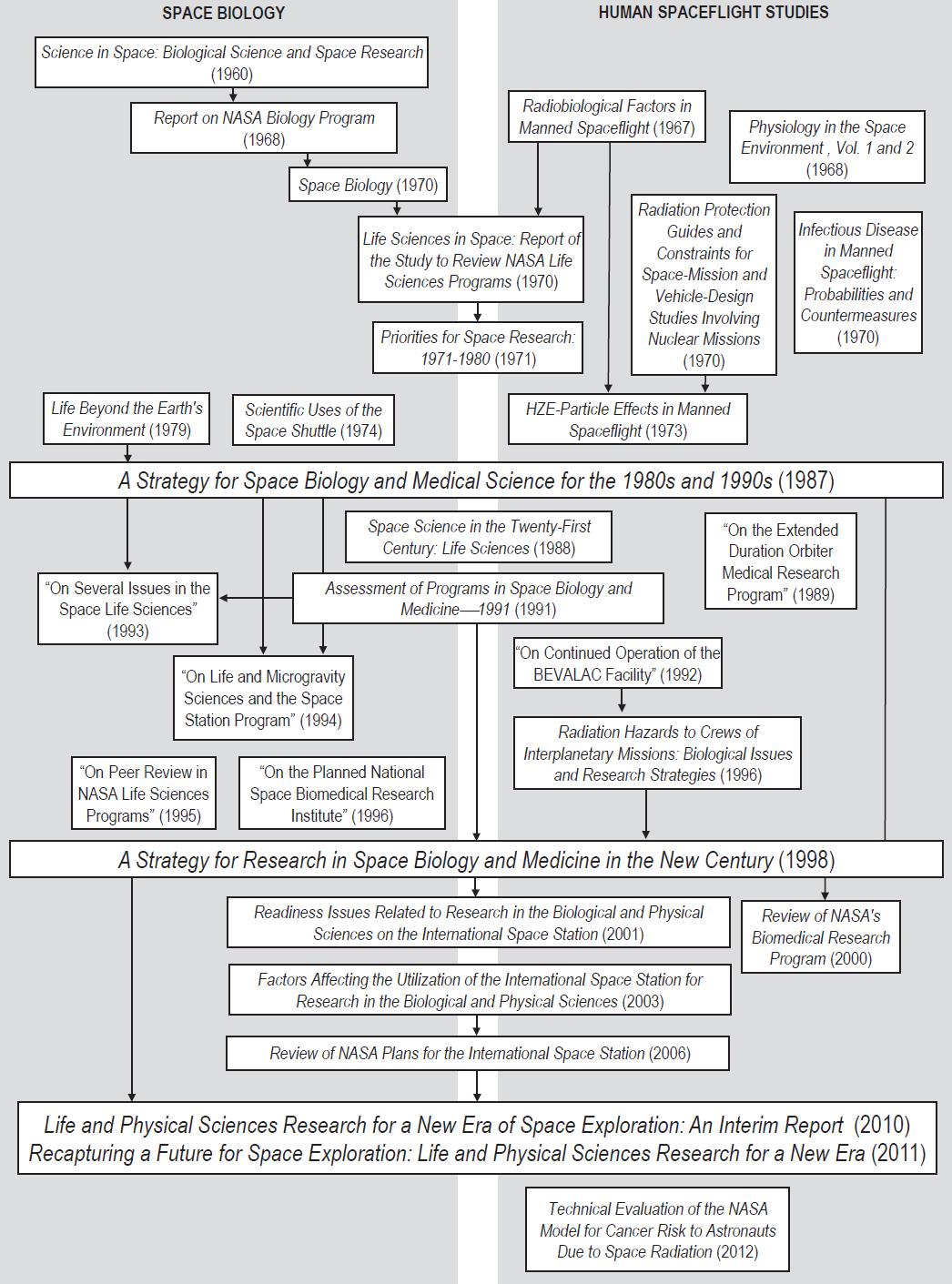
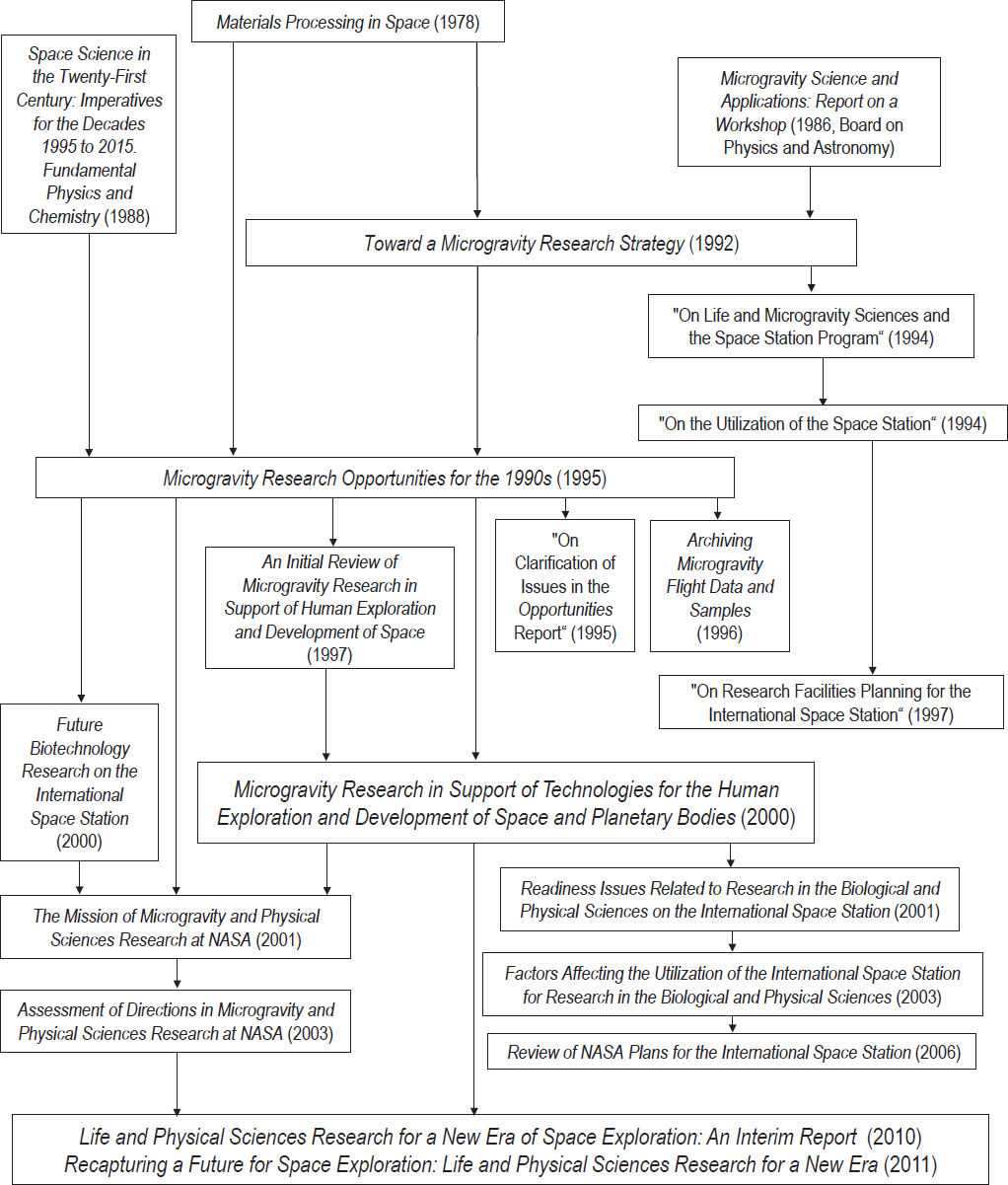
Ofodike A. Ezekoye, University of Texas, Austin
Mohammad Kassemi, Case Western Reserve University
Ronald G. Larson,* University of Michigan
Richard E. Lenski, ‡ Michigan State University
Wayne L. Nicholson,† University of Florida
James A. Pawelczyk, Pennsylvania State University
Marylyn D. Ritchie, Geisinger Health System
Pol D. Spanos, Rice University
Krystyn J. Van Vliet, Massachusetts Institute of Technology
Peter W. Voorhees, Northwestern University
Erika Wagner, Blue Origin, LLC
Eugenia Y.-H. Wang,* University of Louisville
Hai Wang,† Stanford University
David Weitz, Harvard University
Staff
Sandra J. Graham, Senior Program Officer, SSB
Katie Daud, Research Associate, SSB (through December)
Marchel Holle, Research Associate, SSB (from October)
Dionna Wise, Program Coordinator, SSB
___________________
* Term ended July 31, 2016.
† Became a member August 4, 2016.
‡ Resigned from the committee August 1, 2016.
COMMITTEE ON EARTH SCIENCE AND APPLICATIONS FROM SPACE
The Committee on Earth Science and Applications from Space met March 29-30 during the SSB’s annual Space Science Week in Washington, D.C. Principal agenda items included a discussion with Lawrence Friedl (Director, NASA Applied Sciences Program); a discussion about the European Earth Observation Programs with Jean-Luc Bald (European Union) and Maurice Borgeaud (European Space Agency); a discussion on implementing the value framework of the 2015 report Continuity of NASA Earth Observations from Space: A Value Framework with Byron Tapley (University of Texas, Austin), Bruce Wielicki (NASA LaRC), and Randy Friedl (JPL; by telephone); a discussion on big data and Earth science with Ed Kearns (NOAA); and Earth science research on the ISS with Julie Robinson (ISS Chief Scientist, NASA).
CESAS met on October 4-5, 2016 in Washington, D.C. In addition to agency-provided updates on the land imaging programs at USGS and activities within NASA’s Earth Science Division and NOAA National Environmental Satellite, Data, and Information Service, the meeting featured sessions devoted to an exploration of data issues of interest to both the committee and to the work of the decadal survey “ESAS 2017.” Among the topics explored were big data and Earth science, the impact of cloud computing, new roles for the commercial sector in data acquisition and processing, and whether there are areas that require near-term attention to prepare for Earth science data needs through the decadal survey interval, 2017-2027, and beyond.
The CESAS website, http://sites.nationalacademies.org/SSB/SSB_066587 has further information, including links to presentations, for this and other recent meetings.
A historical summary of a selection of SSB advisory reports on Earth science and applications from space is presented in Figure 2.6.
Membership
Michael D. King,* University of Colorado, Boulder (co-chair)
Joyce E. Penner,† University of Michigan (co-chair)
Mark R. Abbott, Woods Hole Oceanographic Institution

Steven A. Ackerman,† University of Wisconsin, Madison
Stacey W. Boland,† Jet Propulsion Laboratory
Antonio J. Busalacchi, Jr.,† University Corporation for Atmospheric Research
Lennard A. Fisk, University of Michigan
Lee-Lueng Fu,† Jet Propulsion Laboratory
Efi Foufoula-Georgiou, University of California, Irvine
Chelle L. Gentemann,† Earth and Space Research
Michael D. King,‡ University of Colorado, Boulder
Molly K. Macauley,§ Resources for the Future
David L. Skole, Michigan State University
Steven C. Wofsy,† Harvard University
Staff
Arthur A. Charo, Senior Program Officer, SSB
Charlie Harris, Research Associate, SSB (through August)
Marchel Holle, Research Associate (from October)
Andrea Rebholz,** Program Coordinator, ASEB
___________________
* Became a member March 21, 2016.
† Term ended December 31, 2016.
‡ Term ended March 20, 2016.
§ Deceased July 8, 2016.
** Staff from other Boards who are shared with the SSB.
COMMITTEE ON SOLAR AND SPACE PHYSICS
The Committee on Solar and Space Physics met March 29-31, 2016, in Washington, D.C., as part of Space Science Week. At the meeting, CSSP heard briefings from Michael Liemohn, University of Michigan, on topics from the NAC Science Committee–Heliophysics Subcommittee and from Byron Tapley, University of Texas, Austin, chair of the study for Continuity of NASA Earth Observations from Space: A Value Framework. The committee received updates from Steven Clarke, NASA, on the NASA Heliophysics Division, from Thomas Berger, NOAA, on the Space Weather Prediction Center, from Therese Moretto-Jorgensen, NSF, on the Geospace Division, and from David Boboltz, NSF, on the Astronomy Division and the National Solar Observatory and the Daniel K. Inouye Solar Telescope. The committee also held discussions on NASA’s Living With a Star program and decadal survey goals, NASA’s Solar Terrestrial Probes Program, heliophysics science centers, and a panel discussion on the National Space Weather Action Plan with representatives from NOAA, NASA, NSF, and the Department of Defense. The committee also began a discussion of planning for the solar and space physics decadal survey midterm assessment, preparing material on their discipline for the transition team of the incoming administration, and details of CSSP’s rotation of committee members for Fall 2016.
The committee did not meet in person in the second and third quarters, but met via teleconference monthly to discuss current events and for meeting planning. At its fall meeting on October 5-7, 2016, in Washington, D.C., the committee heard agency updates from NASA Heliophysics, the NSF Geospace Section, the NSF Division of Astronomical Sciences, and NOAA. The committee also heard an update on NASA’s Solar Probe Plus mission and an overview of topics discussed by the NAC Science Committee–Heliophysics. For the meeting’s second day, CSSP held a focus session on “Gaps in Space Weather Forecasting,” featuring presentations and discussions from NASA, NOAA, the U.S. Air Force, and the Office of the Federal Coordinator for Meteorology as well as science-focused talks from Lisa Upton, High Altitude Observatory; Ryan McGranaghan, Dartmouth College; and Andrés Muñoz-Jaramillo, Georgia State University. On the third day, the committee held follow-up discussions with NASA Heliophysics and discussed possible topics for study by the SSB.
Further information about the committee is available at http://sites.nationalacademies.org/SSB/SSB_052324.
A historical summary of a selection of SSB advisory reports on space and solar physics is presented in Figure 2.7.
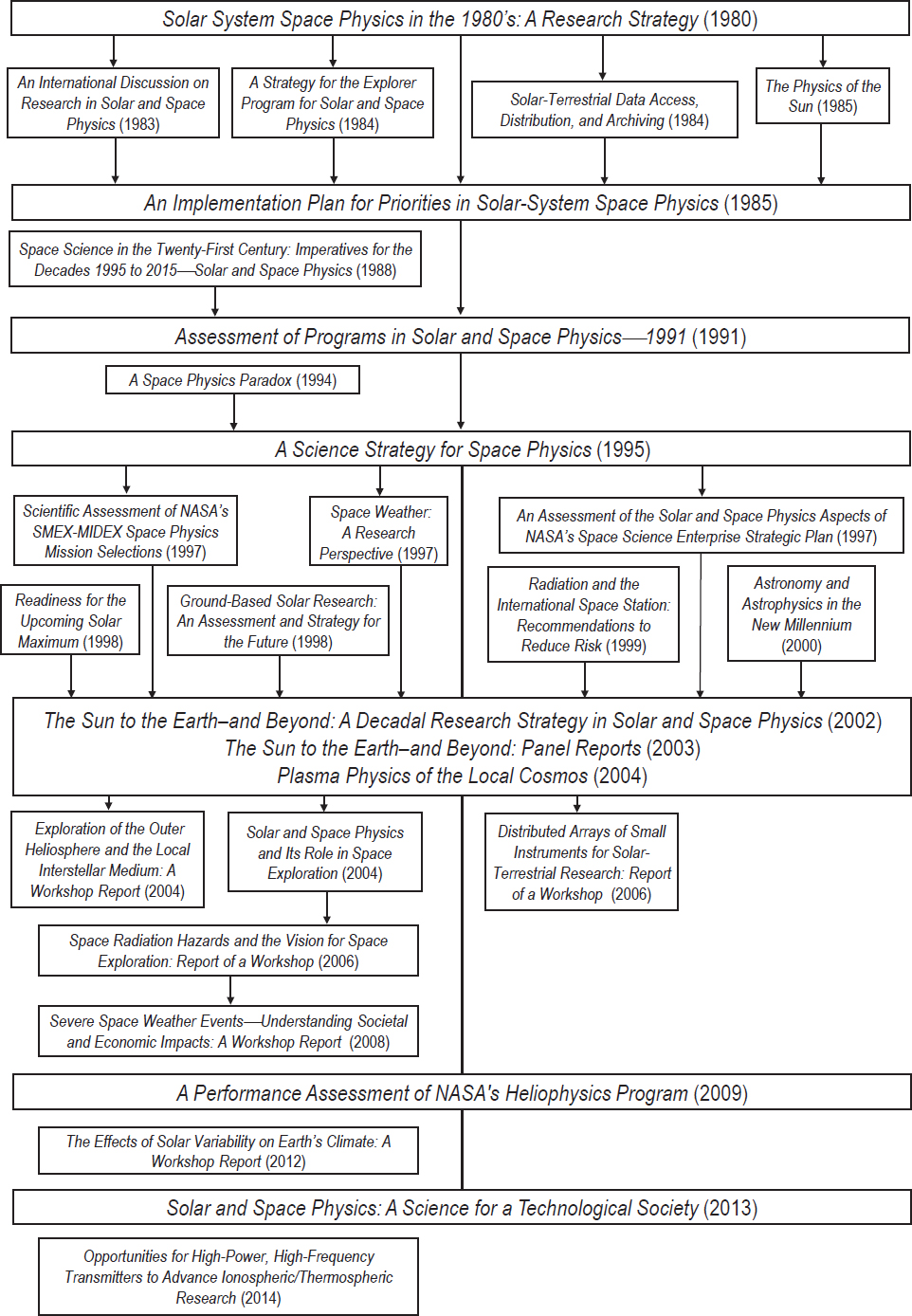
Membership
J. Todd Hoeksema, Stanford University (co-chair)
Mary K. Hudson, Dartmouth College (co-chair)
Timothy S. Bastian, National Radio Astronomy Observatory
Amitava Bhattacharjee, Princeton University
Stephen A. Fuselier, Southwest Research Institute
George M. Gloeckler, University of Michigan
Thomas J. Immel, University of California, Berkeley
Justin Kasper, University of Michigan
Louis J. Lanzerotti, New Jersey Institute of Technology
Judith L. Lean, Naval Research Laboratory
Elizabeth A. MacDonald,* NASA Goddard Space Flight Center
Robyn Millan, Dartmouth College
Terrance G. Onsager, National Oceanic and Atmospheric Administration
Aaron Ridley, University of Michigan
Nathan A. Schwadron, University of New Hampshire
Joshua Semeter, Boston University
Staff
Abigail A. Sheffer, Program Officer, SSB
Charlie Harris, Research Associate, SSB (through August)
Marchel Holle, Research Associate, SSB (from October)
Anesia Wilks, Senior Program Assistant, SSB
___________________
* Resigned from committee May 26, 2016.



















